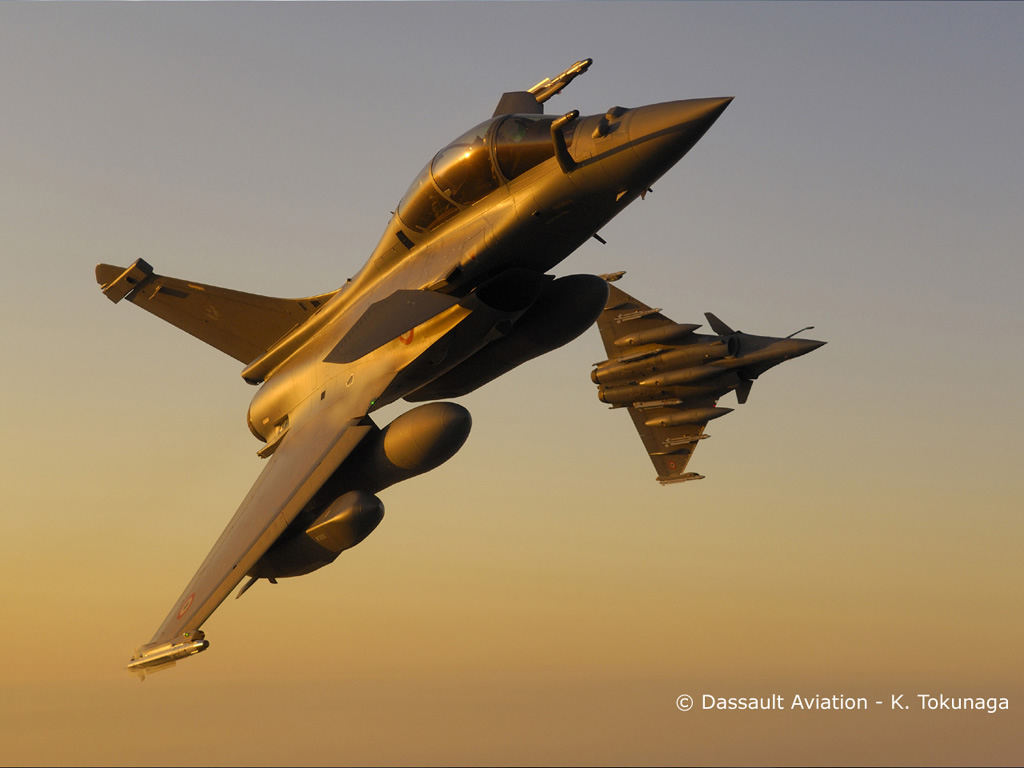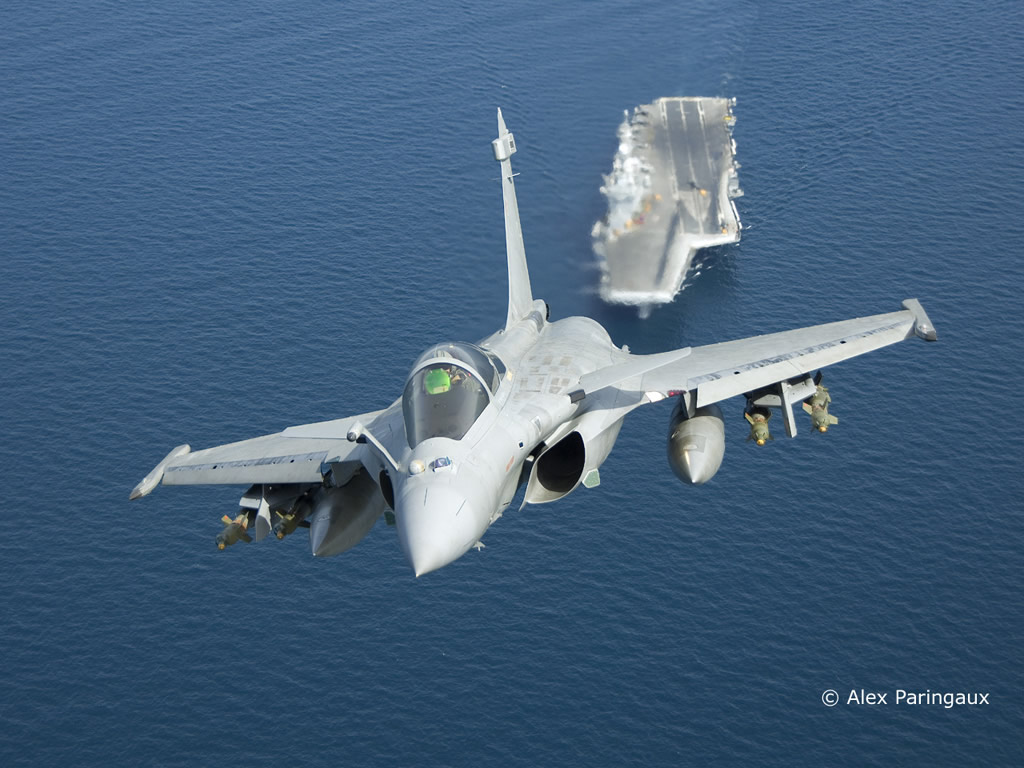he Rafale is a 9.5 – 10.5 tonne aircraft powered by 2 SNECMA M88 jet engines, each generating up to 16,500 pounds thrust with afterburner. Canards are used to improve maneuverability, especially for snap-shots in short-range dogfights, and radar shaping lowers the aircraft’s profile relative to 4th generation competitors like the Mirage 2000 or F-16. Carrier capability was a prime motivator behind France’s decision to go it alone with the Rafale program, and variants exist for both land-based and carrier use.
Despite its size, the Rafale can carry an impressive set of ordnance beyond its 30mm DEFA 791 cannon: up to 9.5 tonnes of weapons and stores on 14 pylons (1-2 on center fuselage, 2 below engine intakes, 6 underwing and 2 wingtip pylons), 5 of which are “wet” pylons that can carry heavy stores or fuel tanks. Its RBE2 mechanically-scanned array radar can direct MBDA’s MICA missiles, and future integration of the long-range Meteor is also planned. A combination of Thales/SAGEM’s OST Infrared Scan and Track optronics, and MBDA’s MICA IR medium-range missiles, allows the Rafale to supplement its radar-guided ordnance with no-warning attacks on enemy aircraft from beyond visual range. At present, this capability is only duplicated by Sukhoi’s SU-27/30 family, and advanced MiG-29s.
The aircraft comes in several broad types, and also comes in different capability tranches.
Carrier-capable Rafales are single-seat fighters, and are referred to as Rafale Ms. They will become the French Navy’s only fighters, replacing the F-8P Crusader fighter, Etendard IVP reconnaissance aircraft, and Super Etendard strike aircraft. They feature the usual set of carrier modifications, including lengthened and strengthened landing gear, strengthened airframe and arrester hook for landings, and carrier landing electronics. The front-center pylon is deleted on this version, in order to make room for that landing gear.
French Air Force Rafales come in 2 broad types: the preferred 2-seat Rafale B, and the single-seat Rafale C. They will eventually replace the SEPECAT Jaguar, Dassault’s Mirage F1, and most of the Mirage 2000 family in French service.
Within those designations, Dassault’s Rafales also come in capability tranches that are common across all versions.
Initial Rafale F1s are limited to air superiority missions, and included only Rafale-Ms intended as urgent replacements for the 1950s/60s era F 8P that served as the French carrier force’s air superiority fighters. Rafale F1s are capable fighters and represented a huge upgrade for the Marine Nationale, but even in air superiority mode they lack the wide weapons fit of 4+ generation counterparts like the JAS-39 Gripen or modern F-15 Strike Eagles, the optimized cockpit and defensive systems of EADS’ Eurofighter, or the price advantages of Sukhoi’s SU-30 family.
Most of the Rafales currently in service are built to the F2 standard, which adds the ability to carry and use precision ground attack weapons. This standard includes 2-seat air force Rafale-Bs, single-seat Rafale-Cs, and naval Rafale-Ms. Key additions include radar ground attack and terrain-following modes, carriage of laser-guided bombs and Storm Shadow/ Scalp cruise missiles, its OSF IRST sensor and MICA IR missile capability, Link 16 datalink, and a buddy tanker pod for Rafale Ms. The F2 standard does not include integration of independent laser targeting capability, however, which is why French Rafales over Afghanistan had to operate in conjunction with Super Etendard and Mirage 2000D fighters.
Since 2008, all Rafales have been delivered in the F3 standard, which adds the ability to carry French ASMP-A air-launched nuclear missiles, allowing the Rafale to replace the Mirage 2000N in that role. Other modifications include full integration with the Reco NG reconnaissance pod, implementation of all currently planned modes for the RBE2 radar, antiship attack with the Exocet or ANF, the Gerfaut helmet-mounted sight, and support for an improved tanker pack.
The batch ordered in 2009 will also have improved protection suites and Thales’ RBE2-AA AESA radar, replacing the mechanically-scanned RBE2 array on previous aircraft. Full integration with Thales’ Damocles surveillance and targeting pod was expected to be complete by 2010, and Damocles-equipped Rafales were used over Libya in 2011. Efforts to include MBDA’s Meteor long-range air-air missiles are ongoing. Some sources refer to Rafales fielded with all of these modifications as Rafale F4s, but the type has not been formally defined yet.
Nuclear ASMP-A capability is irrelevant to exports, but the addition of an AESA radar and full independent precision strike capability will go a long way toward making the Rafale more competitive with challengers like American F-16/15/18s, Saab’s JAS-39NG Gripen, EADS’ Eurofighter Typhoon, and the oncoming F-35 program.















Awesome Capture.
ReplyDelete